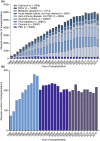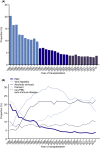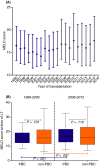Trends in liver transplantation for primary biliary cholangitis in Europe over the past three decades
- PMID: 30561112
- PMCID: PMC6590354
- DOI: 10.1111/apt.15060
Trends in liver transplantation for primary biliary cholangitis in Europe over the past three decades
Abstract
Background: The importance of primary biliary cholangitis as an indication for liver transplantation has probably been influenced by the introduction of therapies, and changes in selection criteria and disease epidemiology.
Aims: To assess the time trends in liver transplantation for primary biliary cholangitis and to evaluate the characteristics of the patient population during the past three decades.
Methods: Patients undergoing liver transplantation from 1986 to 2015 in centres reporting to the European Liver Transplantation Registry were included. We excluded combined organ transplantations and patients <18 years. Trends were assessed using linear regression models.
Results: We included 112 874 patients, of whom 6029 (5.3%) had primary biliary cholangitis. After an initial increase in the first decade, the annual number of liver transplantation for primary biliary cholangitis remained stable at around 200. The proportion of liver transplantations for primary biliary cholangitis decreased from 20% in 1986 to 4% in 2015 (P < 0.001). Primary biliary cholangitis was the only indication showing a consistent proportional decrease throughout all decades. From the first to the third decade, the age at liver transplantation increased from 54 (IQR 47-59) to 56 years (IQR 48-62) and the proportion of males increased from 11% to 15% (both P < 0.001).
Conclusions: We have found a proportional decrease in primary biliary cholangitis as indication for liver transplantation. However, despite treatment with ursodeoxycholic acid and improved disease awareness, the absolute annual number of liver transplantations has stabilised.
© 2018 The Authors. Alimentary Pharmacology & Therapeutics Published by John Wiley & Sons Ltd.
Figures





Comment in
-
Editorial: liver transplantation for primary biliary cholangitis-the need for timely and more effective treatments. Authors' reply.Aliment Pharmacol Ther. 2019 Feb;49(4):473-474. doi: 10.1111/apt.15118. Aliment Pharmacol Ther. 2019. PMID: 30689255 No abstract available.
-
Editorial: liver transplantation for primary biliary cholangitis-the need for timely and more effective treatments.Aliment Pharmacol Ther. 2019 Feb;49(4):472-473. doi: 10.1111/apt.15095. Aliment Pharmacol Ther. 2019. PMID: 30689256 No abstract available.
References
-
- Carey EJ, Ali AH, Lindor KD. Primary biliary cirrhosis. Lancet. 2015;386:1565‐1575. - PubMed
-
- European Association for the Study of the Liver . Electronic address eee. Results: Overall indications and results; 2017.
-
- Boonstra K, Beuers U, Ponsioen CY. Epidemiology of primary sclerosing cholangitis and primary biliary cirrhosis: a systematic review. J Hepatol. 2012;56:1181‐1188. - PubMed
-
- Griffiths L, Dyson JK, Jones DE. The new epidemiology of primary biliary cirrhosis. Semin Liver Dis. 2014;34:318‐328. - PubMed
-
- Beuers U, Gershwin ME, Gish RG, et al. Changing nomenclature for PBC: From 'cirrhosis' to 'cholangitis'. Clin Res Hepatol Gastroenterol. 2015;39:e57–e59. - PubMed
Publication types
MeSH terms
Substances
Grants and funding
LinkOut - more resources
Full Text Sources
Medical
Miscellaneous
